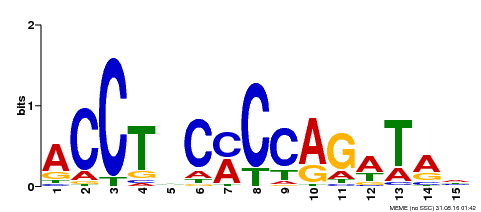 |
PlantRegMap/PlantTFDB v5.0
Plant Transcription
Factor Database
|
| Home TFext BLAST Prediction Download Help About Links PlantRegMap |
Transcription Factor Information
| Basic Information? help Back to Top | |||||||||
|---|---|---|---|---|---|---|---|---|---|
| TF ID | Itr_sc000984.1_g00007.1 | ||||||||
| Organism | |||||||||
| Taxonomic ID | |||||||||
| Taxonomic Lineage |
cellular organisms; Eukaryota; Viridiplantae; Streptophyta; Streptophytina; Embryophyta; Tracheophyta; Euphyllophyta; Spermatophyta; Magnoliophyta; Mesangiospermae; eudicotyledons; Gunneridae; Pentapetalae; asterids; lamiids; Solanales; Convolvulaceae; Ipomoeeae; Ipomoea
|
||||||||
| Family | C2H2 | ||||||||
| Protein Properties | Length: 507aa MW: 55948.4 Da PI: 6.1967 | ||||||||
| Description | C2H2 family protein | ||||||||
| Gene Model |
|
||||||||
| Signature Domain? help Back to Top | |||||||
|---|---|---|---|---|---|---|---|
| No. | Domain | Score | E-value | Start | End | HMM Start | HMM End |
| 1 | zf-C2H2 | 21.1 | 8.4e-07 | 259 | 280 | 2 | 23 |
EETTTTEEESSHHHHHHHHHHT CS
zf-C2H2 2 kCpdCgksFsrksnLkrHirtH 23
C++Cgk F+r nL+ H+r H
Itr_sc000984.1_g00007.1 259 FCTICGKGFKRDANLRMHMRGH 280
6*******************98 PP
| |||||||
| Protein Features ? help Back to Top | ||||||
|---|---|---|---|---|---|---|
| Database | Entry ID | E-value | Start | End | InterPro ID | Description |
| SuperFamily | SSF57667 | 2.35E-5 | 256 | 283 | No hit | No description |
| PROSITE profile | PS50157 | 12.03 | 258 | 285 | IPR007087 | Zinc finger, C2H2 |
| SMART | SM00355 | 0.0026 | 258 | 280 | IPR015880 | Zinc finger, C2H2-like |
| Gene3D | G3DSA:3.30.160.60 | 5.4E-6 | 259 | 309 | IPR013087 | Zinc finger C2H2-type/integrase DNA-binding domain |
| PROSITE pattern | PS00028 | 0 | 260 | 280 | IPR007087 | Zinc finger, C2H2 |
| SMART | SM00355 | 62 | 307 | 340 | IPR015880 | Zinc finger, C2H2-like |
| SMART | SM00355 | 25 | 345 | 367 | IPR015880 | Zinc finger, C2H2-like |
| Gene Ontology ? help Back to Top | ||||||
|---|---|---|---|---|---|---|
| GO Term | GO Category | GO Description | ||||
| GO:0006355 | Biological Process | regulation of transcription, DNA-templated | ||||
| GO:0010044 | Biological Process | response to aluminum ion | ||||
| GO:0010447 | Biological Process | response to acidic pH | ||||
| GO:0005634 | Cellular Component | nucleus | ||||
| GO:0003676 | Molecular Function | nucleic acid binding | ||||
| GO:0003700 | Molecular Function | transcription factor activity, sequence-specific DNA binding | ||||
| GO:0046872 | Molecular Function | metal ion binding | ||||
| Sequence ? help Back to Top |
|---|
| Protein Sequence Length: 507 aa Download sequence Send to blast |
MDPDNGLDSD PWTKSSLSCN DFLENVPPDD QPFNVFTLQQ QKWESSFLNQ LNQPAQNQSS 60 VSTINNIQIR VPDQQDTQAC DSNKIQEWDP KTMLNNLSFL EKKIHELQDL VHVIVGRRGQ 120 VGFQANELLV QQQQLITADL TSIIVQLIST AGSLLPTVKH TLSYAGQAAQ LVQSGGVATP 180 SGAGFNSSAL PQSVNVSKVE DHSIHIDPVG DSGMDQNCTV EEHELKDEDE AEEEENLPPG 240 SYEILQLEKE EILAPHTHFC TICGKGFKRD ANLRMHMRGH GDEYKTPAAL AKPHKEVSSV 300 PALIKRYSCP YVGCKRNREH KKFQPLKTIL CVKNHYKRTH CEKSYTCSRC NIKKFSVIAD 360 LKTHEKHCGK DKWLCSCGTT FSRKDKLFGH IALFQGHTPA IPLDDHKGSS SGLSDQGQNT 420 AGQIDPKLNN AYSGSGSGSP QNAIDVKGSV NDPGNYFSPM NYDTGDLGGF QDFPRVPFED 480 SNSSFSFLLS GSCDYPQKAG KYGSSSE |
| Functional Description ? help Back to Top | ||||||
|---|---|---|---|---|---|---|
| Source | Description | |||||
| UniProt | Probable transcription factor. Together with STOP2, plays a critical role in tolerance to major stress factors in acid soils such as proton H(+) and aluminum ion Al(3+). Required for the expression of genes in response to acidic stress (e.g. ALMT1 and MATE), and Al-activated citrate exudation. {ECO:0000269|PubMed:17535918, ECO:0000269|PubMed:18826429, ECO:0000269|PubMed:19321711, ECO:0000269|PubMed:23935008}. | |||||
| Binding Motif ? help Back to Top | |||
|---|---|---|---|
| Motif ID | Method | Source | Motif file |
| MP00196 | ampDAP | Transfer from AT1G34370 | Download |

| |||
| Regulation -- Description ? help Back to Top | ||||||
|---|---|---|---|---|---|---|
| Source | Description | |||||
| UniProt | INDUCTION: By shock H(+) and Al(3+) treatments. {ECO:0000269|PubMed:17535918}. | |||||
| Annotation -- Protein ? help Back to Top | |||||||
|---|---|---|---|---|---|---|---|
| Source | Hit ID | E-value | Description | ||||
| Refseq | XP_019180664.1 | 0.0 | PREDICTED: protein SENSITIVE TO PROTON RHIZOTOXICITY 1 | ||||
| Refseq | XP_019180665.1 | 0.0 | PREDICTED: protein SENSITIVE TO PROTON RHIZOTOXICITY 1 | ||||
| Swissprot | Q9C8N5 | 0.0 | STOP1_ARATH; Protein SENSITIVE TO PROTON RHIZOTOXICITY 1 | ||||
| TrEMBL | A0A1Q3CHW4 | 0.0 | A0A1Q3CHW4_CEPFO; Zf-C2H2 domain-containing protein | ||||
| STRING | XP_009620662.1 | 0.0 | (Nicotiana tomentosiformis) | ||||
| Orthologous Group ? help Back to Top | |||
|---|---|---|---|
| Lineage | Orthologous Group ID | Taxa Number | Gene Number |
| Asterids | OGEA4754 | 24 | 41 |
| Best hit in Arabidopsis thaliana ? help Back to Top | ||||||
|---|---|---|---|---|---|---|
| Hit ID | E-value | Description | ||||
| AT1G34370.2 | 1e-170 | C2H2 family protein | ||||



